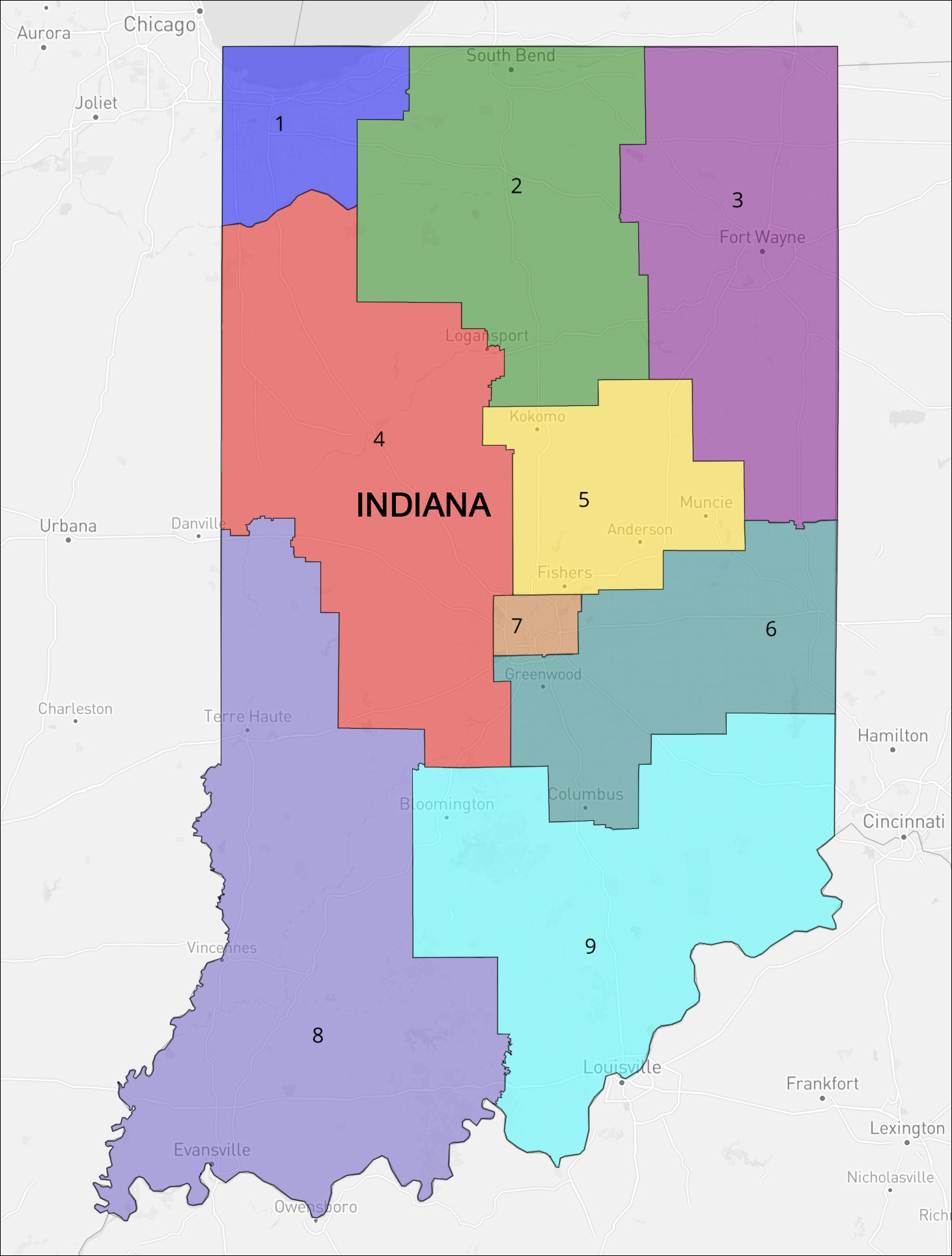
Current Indiana US House Congressional Districts map / Click on image to go to interactive version on Dave’s Redistricting App.
By Jim Ellis — Wednesday, Oct. 29, 2025
Redistricting
It appears we are seeing another state poised to join the mid-decade redistricting wars as an active participant.
Indiana Gov. Mike Braun (R) summoned the legislature back into session on Monday to work several issues and congressional redistricting is expected to be among them. It is now clear that Indiana will play a major role in how the new redistricting wave unfolds.
Developments favorable to Democrats in certain other states have now put selected Republican state leaders under further political pressure to attempt to neutralize those projected gains.
Indiana is one such place. Reports have been in the public domain for weeks saying that the White House, including Vice President J.D. Vance, who has met with Hoosier State legislative leaders on more than one occasion, have been overtly working to convince reluctant legislators to move forward. Gov. Braun has been supportive of the effort from the beginning.
Now, it appears we will see movement. The current Indiana congressional map features seven Republicans and two Democrats, but some believe the legislature could draw a 9R-0D map. Whether they go that far remains to be seen.
The Republicans’ obvious first target will be northwestern Indiana Congressman Frank Mrvan (D-Highland/Gary). His 1st District has become more competitive as evidenced by his lower than expected 53 percent average in his last two elections. Additionally, the Republican who ran strongly against Rep. Mrvan in 2022, retired US Air Force officer Jennifer-Ruth Green, is reportedly open to running again in a more favorable district.
The state’s other Democratic member is Rep. Andre Carson (D-Indianapolis), who has served nine full terms and part of another. Carson’s current 7th District is solidly Democratic (Dave’s Redistricting App partisan lean: 67.9D – 29.0R) meaning the new map would have to break his district into segments in order to create another Republican seat.
If the map-drawers pursue such a course, the pie-shaped format might be overlayed into the Indianapolis region. The pie-shape concept brings contiguous districts into a metro area sometimes for partisan reasons, though many point out that such a draw gives a particular metropolitan area more representation and thus the region has a stronger presence in Congress.
Should the Indiana legislators adopt such a strategy, Districts 4 (Rep. Jim Baird-R), 5 (Rep. Victoria Spartz-R), and 6 (Rep. Jefferson Shreve-R), would likely be fundamentally reconfigured. It is probable all of these districts would come into Marion County (only Rep. Shreve’s District 6 does now) to take a piece of Indianapolis city and non-city precincts, thereby stretching the 7th CD into more rural Republican areas.
Polling is now suggesting the California redistricting referendum will pass on Nov. 4 (latest released California survey: Emerson College — Yes 57, No 37). Therefore, Democrats could be in position to gain five Golden State seats according to the party’s projections.
Additionally, the Utah courts have ordered a redraw of that state’s congressional map because of a ruling saying the legislature, when constructing the current plan in 2021, ignored map construction criteria that voters approved in the previous decade. As a result, Democrats are likely to gain one seat from the Beehive State.
Therefore, Democrats will potentially gain six seats in California and Utah, and possibly one more if Maryland decides to redistrict.
There is also public discussion occurring indicating that Virginia could join the redraw fray if former Congresswoman Abigail Spanberger (D) wins the Governor’s race on Nov. 4. Even with a Democratic trifecta (Governor, state Senate, and state House of Delegates, which would occur with a Spanberger victory), redistricting would be no sure thing.
Virginia now has a hybrid redistricting commission composed of elected officials and citizens that have map drawing power. Therefore, the legislature will have to change the state’s redistricting structure in order to replace the current map. If they find a way, however, the Democrats could certainly make gains in the state since Republicans now hold five of Virginia’s 11 congressional districts.
Republicans would still come out ahead toward their goal of expanding the GOP Conference despite the aforementioned Democratic gains, however. It is probable that five seats would come from Texas, one on Missouri’s new map, one from North Carolina, all of which are complete, and further possible additions from Indiana as discussed, Florida, and Ohio (gaining two in each state). Louisiana and Alabama would likely follow suit if the Supreme Court eventually upholds the lower court ruling on the case currently before the justices.
